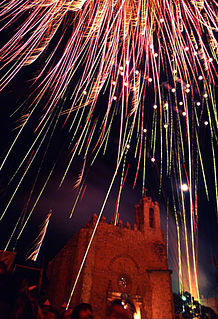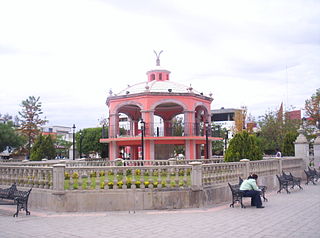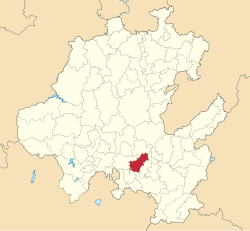
Hidalgo, officially the Free and Sovereign State of Hidalgo, is one of the 32 states which constitute the Federal Entities of Mexico. It is divided into 84 municipalities and its capital city is Pachuca de Soto.

Pachuca, formally known as Pachuca de Soto, is the capital and largest city of the Mexican state of Hidalgo. It is located in the south-central part of the state. Pachuca de Soto is also the name of the municipality of which the city serves as municipal seat. Pachuca is located about 90 kilometres (56 mi) from Mexico City via Mexican Federal Highway 85. There is no consensus about the origin of the name Pachuca. It has been traced to the word pachoa, Pachoacan, and patlachuican.

Hidalgo is a state in East Mexico that is divided into 84 municipalities. According to the 2015 Mexican Intercensal Survey, Hidalgo is the 17th most populous state with 2,858,359 inhabitants and the 26th largest by land area spanning 20,813 square kilometres (8,036 sq mi).

Ojinaga Municipality is one of the 67 municipalities of Chihuahua, in northern Mexico. The municipal seat lies at Ojinaga, a rural bordertown on the U.S.-Mexico border. The municipality has an area of 9,500.50 km².

Mineral del Monte, commonly called Real del Monte or El Real, is a small mining town, and one of the 84 municipalities of Hidalgo, in the State of Hidalgo in east-central Mexico.

Villaflores Municipality is a municipio (municipality) in the state of Chiapas, southern Mexico, and the name of its largest settlement and seat of the municipal government. Situated in the Sierra Madre de Chiapas range, the municipality has an area of approximately 1232 km2 at an average elevation of 540m above mean sea level.

Hidalgo del Parral is one of the 67 municipalities of Chihuahua, in northern Mexico. The municipal seat lies at Hidalgo del Parral. The municipality covers an area of 1,751 km².

Tepezalá is a municipality and town in the Mexican state of Aguascalientes. The town of Tepezalá serves as the municipal seat for the surrounding municipality of Tepezalá.

Acatlán is a town and municipality located in the Mexican state of Hidalgo, about ten km northwest of the city of Tulancingo and 147 km from Mexico City. The main landmark is the San Miguel monastery which was built in the 16th century. It is partially in ruins but there have been efforts since the 1980s to restore it. Acatlán comes from a Nahuatl phrase which means “near the reeds”.

Ajacuba is a town and one of the 84 municipalities of Hidalgo, in central Mexico. The municipality covers an area of 192.7 km².

Atotonilco de Tula is one of the 84 municipalities of Hidalgo. It is located in the central-southeastern part of the state of Hidalgo in Mexico. The municipal seat is Atotonilco de Tula. The municipality is located at a southern pass leading out of the Mezquital Valley to 86 kilometers north of Mexico City and about 180 km northeast of the state capital of Pachuca de Soto. The name comes from Nahuatl and means "place of hot springs" and otomi language is Padehe. The municipality covers an area of 31 km².

Mineral de la Reforma is one of the 84 municipalities of Hidalgo, in central-eastern Mexico. Adjacent to Pachuca in the same built up area, it is one of the fastest growing cities of Hidalgo State. As of 2005, the municipality had a total population of 68,704.

San Agustín Tlaxiaca is a town and one of the 84 municipalities of Hidalgo, in central-eastern Mexico. The municipality covers an area of 354.6 km².

Apaxco is a municipality located in the Zumpango Region in Mexico. The municipal territory is located at a southern pass leading out of the Mezquital Valley about 288 km (179 mi) northeast of the state capital of Toluca. The name Apaxco comes from Nahuatl.

Tlaxco is a municipality in Tlaxcala, Mexico.

Río Grande is a municipality in the Mexican state of Zacatecas.

Las Minas is a municipality in the Mexican state of Veracruz, located 28 kilometres (17 mi) northeast of the state capital Xalapa.

Tepetzintla is a municipality in the Mexican state of Veracruz, located 207 kilometres (129 mi) northwest of the state capital of Xalapa and 119 kilometres (74 mi) south of the city of Tampico.

Zacualpan is a municipality in the Mexican state of Veracruz, located 179 kilometres (111 mi) northwest of the state capital of Xalapa and 56 kilometres (35 mi) northeast of the city of Pachuca, Hidalgo.
The Pachuca Range is a mountain range in the Sierra Madre Oriental of central Mexico, in the state of Hidalgo.



















